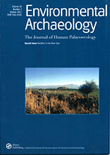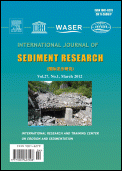
VEGETATION HISTORY AND ARCHAEOBOTANY
metrics 2024
Illuminating the Interplay of Flora and Civilization
Introduction
Vegetation History and Archaeobotany is an esteemed academic journal published by Springer, dedicated to the exploration of the interactions between vegetation, human activity, and the archaeological record. With its history spanning from 1992 to 2024, the journal has established a significant presence in the academic community, particularly with its strong impact reflected in its Q1 rankings across diverse fields such as Archaeology, Paleontology, and Plant Science. The journal consistently ranks among the top publications, achieving remarkable positions such as 12th in Archeology and 9th in Paleontology according to Scopus, which underscores its influence and quality in the field. Aimed at researchers, professionals, and students alike, Vegetation History and Archaeobotany serves as a crucial resource for those seeking to understand the pivotal role of plant remains in reconstructing past environments and human interactions. Readers can expect to find rigorously reviewed articles that contribute to the ongoing discourse in vegetation studies and archaeological science.
Metrics 2024
 0.92
0.92 2.10
2.10 2.60
2.60 71
71Metrics History
Rank 2024
Scopus
IF (Web Of Science)
JCI (Web Of Science)
Quartile History
Similar Journals

Malaysian Journal of Soil Science
Empowering Global Perspectives in Soil Science.The Malaysian Journal of Soil Science, published by the Malaysian Society of Soil Science, serves as a vital platform for disseminating high-quality research in the fields of Agronomy and Crop Science as well as Soil Science. With an ISSN of 1394-7990, this peer-reviewed journal has made significant strides since its establishment in 2009, currently positioned in the Q2 quartile for both categories as of 2023. The journal aims to advance knowledge surrounding soil health and management practices, particularly within the Malaysian context, while also addressing global soil science issues. Despite being based in Malaysia, it welcomes contributions from a diverse range of geographies and viewpoints, enriching the academic discourse. Researchers and practitioners in this field will find a wealth of innovative studies and findings that reflect the current trends and challenges in soil management. Given its current rankings in Scopus, the journal plays a crucial role in shaping the future of soil science, making it indispensable for anyone dedicated to advancing research and practical applications in agricultural and environmental sciences.

Magallania
Illuminating Social Issues through Scholarly DiscourseMagallania is a pioneering open-access journal published by UNIV MAGALLANES, dedicated to advancing scholarly discourse in the field of Social Sciences. Since its inception in 2005, the journal has provided a platform for original research, critical reviews, and insightful analyses that address diverse issues affecting society in both local and global contexts. Based in Punta Arenas, Chile, Magallania has established itself as an essential resource for researchers, professionals, and students alike, particularly in its current position within the Q2 category of Social Sciences (miscellaneous) as of 2023. With an ongoing commitment to quality and accessibility, the journal aims to foster interdisciplinary dialogue and promote knowledge exchange, all while contributing to a deeper understanding of social dynamics and challenges. Magallania is indexed in Scopus, ranking competitively in the field; it reflects the dynamic scholarly environment that characterizes the vibrant region of Magallanes and beyond.

JOURNAL OF VEGETATION SCIENCE
Uncovering the intricacies of biodiversity.JOURNAL OF VEGETATION SCIENCE, published by Wiley, stands as a premier platform for disseminating high-quality research within the fields of ecology and plant science. With an impressive rank of #80 out of 516 in Plant Science and #81 out of 461 in Ecology according to Scopus, this esteemed journal is recognized for its significant contributions to advancing knowledge and understanding of vegetation dynamics and biodiversity. Since its inception in 1990, JOURNAL OF VEGETATION SCIENCE has been committed to providing a forum for researchers, professionals, and students to share their findings and engage in critical discussions about the ecological implications of vegetation studies. While this journal does not currently offer open access, it maintains a reputable impact factor, illustrating its importance in contemporary ecological and botanical research. With its Q1 categorization in both Ecology and Plant Science for 2023, it continues to shape and influence the discourse in these disciplines through rigorous peer-reviewed articles, reviews, and synthesis papers.

Prilozi Instituta za Arheologiju u Zagrebu
Exploring critical narratives in archaeology and history.Prilozi Instituta za Arheologiju u Zagrebu is a prominent academic journal published by INST ARHEOLOGIJU, dedicated to advancing the field of archaeology and related historical studies. Operating in Croatia, this journal serves as a vital platform for scholars, researchers, and students to disseminate innovative research and insights within the realm of archaeology, with a focus on the rich cultural heritage of the region. The journal spans contributions from 2002 to 2011 and has ongoing publication since 2013, reflecting its commitment to contemporary archaeological discourse. With a growing reputation, it has achieved a Q3 ranking in the fields of Archaeology and Arts and Humanities, and a Q2 ranking in History, signifying its impact and relevance in the academic community. Although Open Access options are not available, the journal remains an essential resource for those pursuing in-depth knowledge and research in archaeology. Researchers can harness the journal's extensive scope to explore critical historical narratives and archaeological findings, solidifying its importance in both local and global contexts.

ENVIRONMENTAL ARCHAEOLOGY
Uncovering Ancient Interactions to Address Modern ChallengesENVIRONMENTAL ARCHAEOLOGY, published by ROUTLEDGE JOURNALS, TAYLOR & FRANCIS LTD, serves as a leading platform for innovative research at the intersection of archaeology and environmental science. With a commendable history dating back to 1981 and a notable convergence in scholarly discussion from 2002 to 2024, this journal holds an esteemed Q1 ranking in both Archeology and Archeology (arts and humanities), as well as a Q2 in Environmental Science as of 2023. Positioned in the United Kingdom, ENVIRONMENTAL ARCHAEOLOGY's ISSN 1461-4103 and E-ISSN 1749-6314 reflect its commitment to disseminating high-quality research that explores how past human interactions with the environment inform modern ecological challenges. With its robust Scopus standings, including a rank of #17/413 in Arts and Humanities and an impressive #15/354 in Social Sciences, the journal is recognized for its significant contribution to the field, making it an essential resource for researchers, professionals, and students eager to advance their understanding and application of environmental archaeology.

Plants People Planet
Connecting Nature, Nurturing Humanity.Plants People Planet is a leading academic journal published by Wiley, focusing on the intricate relationships between plants, people, and the planet. Since its debut as an Open Access publication in 2019, it has quickly established a significant presence in the scholarly community, achieving impressive rankings in multiple categories. Notably, it holds a prestigious Q1 ranking in Ecology, Evolution, Behavior and Systematics, Forestry, Horticulture, and Plant Science as of 2023. With its dedicated scope addressing crucial ecological and horticultural advancements, this journal is essential for researchers, professionals, and students who aim to explore interdisciplinary approaches to sustainable plant management and environmental stewardship. Operating from the United Kingdom, it serves a global audience of scholars, providing an invaluable platform for disseminating innovative research and fostering collaborative dialogue in these pivotal fields. For those interested in cutting-edge research that bridges the gap between human practices and ecological health, Plants People Planet is a must-publish venue.

PHYTOCOENOLOGIA
Illuminating the Science of Plant InteractionsPHYTOCOENOLOGIA, published by GEBRUDER BORNTRAEGER, is a prominent journal in the field of Plant Science, holding a prestigious position in the academic landscape with a 2023 Scopus rank of #235 out of 516 in its category, reflecting its contributions to agricultural and biological sciences. Since its inception in 1987, the journal has provided a vital platform for researchers, offering insights and disseminating advances in phytoecology and related disciplines. With its strong commitment to quality, PHYTOCOENOLOGIA is classified in the Q3 quartile, making it a valuable resource for professionals and students alike. The journal welcomes diverse research articles, reviews, and case studies that enhance our understanding of plant communities and their ecological dynamics. Although it operates under a traditional access model, it continues to foster a collaborative environment for scholars eager to explore critical issues in plant science.

QUATERNAIRE
Uncovering Geological Insights for a Sustainable Future.QUATERNAIRE is a reputable journal managed by the Société Géologique de France, specializing in the realms of Earth-Surface Processes and Geology. This esteemed publication has been a vital platform for scientific discourse since its inception, presenting compelling research and insights from both fields. With a significant impact in the academic community, it currently holds a Q3 quartile ranking in the 2023 Scopus categories, demonstrating its importance in disseminating knowledge related to geological phenomena. Although QUATERNAIRE does not have an open access model, it ensures that critical research is accessible to a wide audience, enhancing collaboration among geoscientists and environmental researchers. Based in France at 77, Rue Claude-Bernard, Paris F-75005, this journal continues to evolve its publication scope, welcoming contributions that delve into the intricacies of Earth's processes from 1990 to 2024. Researchers, professionals, and students alike will find valuable resources and inspiration within its pages, contributing to a deeper understanding of our planet's past and present.

Palaeontographica Abteilung B-Palaeophytologie Palaeobotany-Palaeophytology
Illuminating the Evolutionary Pathways of PlantsPalaeontographica Abteilung B-Palaeophytologie Palaeobotany-Palaeophytology is a distinguished journal published by E SCHWEIZERBARTSCHE VERLAGSBUCHHANDLUNG in Germany, focusing on the intricate study of paleobotany, including the evolution and diversity of plant life throughout geological time. With an impressive Scopus ranking of #25 out of 113 in the field of paleontology, the journal is recognized for its contribution to advancing our understanding of ancient ecosystems, earning a prestigious Q2 quartile ranking in 2023. Despite its lack of open access options, the journal provides invaluable insights for researchers, professionals, and students alike who are passionate about exploring the fossil record and its implications for plant evolutionary history. The journal's collaborative nature and periodic publication schedule, ranging from 2005 to 2024, ensure that it remains at the forefront of paleontological research.

International Journal of Sediment Research
Pioneering Research in Geology and StratigraphyThe International Journal of Sediment Research, published by KEAI PUBLISHING LTD, stands as a premier platform for advanced studies in the fields of geology and stratigraphy. With an impressive Q1 ranking in both categories in 2023, this journal hosts a wealth of research that has significantly contributed to our understanding of sediment dynamics and geological processes since its inception in 1981. The journal is dedicated to publishing high-quality research articles, reviews, and case studies that span a broad range of topics, including sedimentology, stratigraphic analysis, and environmental geology. Researchers, professionals, and students will find invaluable insights within its pages, courtesy of cutting-edge methodologies and rigorous peer-review standards. Despite its non-open access status, the journal ensures a global reach, facilitating knowledge sharing and collaboration among academia and industry. With a rich history and a forward-looking approach to scientific exploration, the International Journal of Sediment Research remains a vital resource for those committed to advancing our understanding of Earth's sedimentary systems.